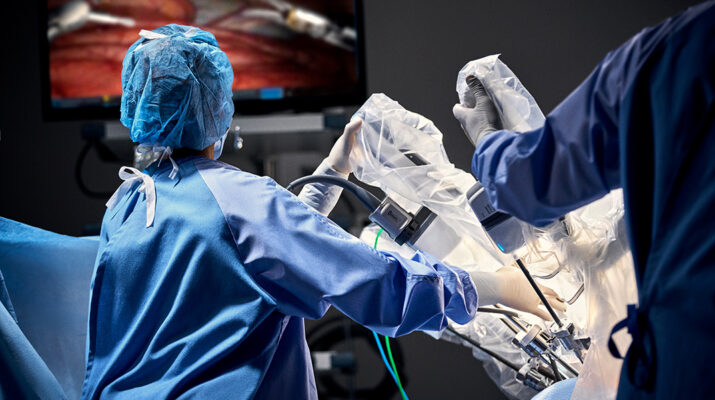By David Podos

In late November and into early December 2024, I was experiencing intermittent pain near my right lower back area. This continued for about a week so I decided to see my primary care physician, who ordered a CAT scan.
The imagery along with the medical notes from the radiologist clearly showed that I had a mass that was in my ureter tube, which connects the kidney to the bladder.
My urologist scheduled me for surgery in early February to place a stent into the ureter tube to alleviate my swollen kidney, which at that time was twice the size of my other kidney. At that surgery it was confirmed that the mass was cancerous.
Because of the size and placement of the tumor it was recommended that surgeon Po Lam perform the surgery using the da Vinci Surgical System.
Lam is the medical director of the robotics program at Rome Health. He also serves as the director of robotic surgery at University Community Campus in Syracuse and is an affiliated urologic surgeon with St. Joseph’s Health and Crouse Health, both in Syracuse.
Lam is a nationally recognized urologist and robotic surgeon. He is part of Associated Medical Professionals, a multi-specialty group having several locations in and around Central New York which include Syracuse, New Hartford, Fayetteville and Oneida. The group specializes in urological, radiation and oncology treatments.
“Through my work with the new da Vinci SP, I’ve seen numerous benefits with this leading-edge technology that is now available to patients close to home in Central New York. This technology gives the surgeon much more freedom of movement and ability to see the anatomy compared to the old system,” Lam said. “One of the major advantages of the single-port surgical technique is reducing the amount of pain during and after robotic surgery. This helps reduce the need for narcotics, which in turn greatly reduces the abuse and potential addiction to narcotics.”
With conventional surgery being used for the removal of my tumor along with the reconstruction of my ureter tube, the surgery would have been approximately three to four hours. With the da Vinci robotic surgery it was just under two hours. Conventional surgery would require me to be admitted for up to several days; with the robotic surgery I was released to go home just three hours post-surgery.
Robotic Surgery: the da Vinci Surgical System
In July of 2000, the da Vinci surgical system began to be used in surgery, following FDA approval.
Robotic surgery allows for a minimally invasive surgery allowing the surgeon precision and control through the use of robotic arms. Assisting the surgeon is the use of a three-dimensional image monitor of the surgical site which allows the surgeon to comfortably sit and view the surgical procedure.
There are many advantages for the patient who receives surgery through the da Vinci system, including reduced pain, quicker recovery times, a much lower risk of infections and a reduced risk of complications during surgery as well as a reduced risk of post-surgical complications.
“Robotic surgery once thought to be a futuristic idea whose time may never come, today, robotic surgery is used in many types of operations, including cardiothoracic, colorectal and head-and-neck surgery to name just a few,” wrote Jim McCartney in an article published in the American College of Surgeons website.
McCartney goes on to say that “robotic surgery has grown significantly over the past 25 years.”
According to Intuitive Surgical, the current market leader in robotic surgery systems, more than 12 million robotic surgery procedures have been performed and more than 60,000 surgeons around the world have been trained on its da Vinci system.
Bright Future
The future looks bright for the da Vinci surgical system. Da Vinci surgical systems are spreading across global markets as the system continues to be implemented for various surgical specialties. The company is investing into more research and development introducing new features and further sophisticated technologies. Recently the company launched the new da Vinci 5 system with 150 enhancements including improved computing power and streamlined workflows, according to Medical Device and Diagnostic Industry. Furthermore, with the ever-increasing influence of A.I. (artificial intelligence), within the medical field, A.I. will enhance the da Vinci surgical system in real-time feedback for surgeons, enhanced precision and improved surgical training to name just a few.
“Patients are able to leave the hospital sooner and recover faster in the comfort of their homes,” Lam said. “With the strain on staffing at all levels, this is helpful to the patient as well as the hospital.”

